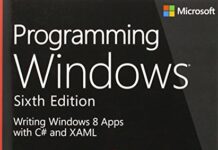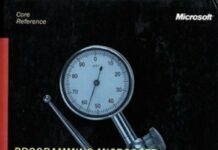
Ebook Info
- Published: 2006
- Number of pages: 1020 pages
- Format: PDF
- File Size: 2.40 MB
- Authors: Charles Petzold
Description
Get the definitive guide to the Windows Presentation Foundation (WPF), the new client programming interface for the Microsoft .NET Framework 3.0 and Windows Vista. Award-winning author Charles Petzold teaches you how to combine C# code and the Extensible Application Markup Language (XAML) to develop applications for the WPF. You’ll get expert guidance and hundreds of practical, hands-on examples—giving you the skills you need to exploit the new interface and graphics capabilities for Windows Vista.Discover how to:Create and enhance controls including menus, toolbars, tree views, and list viewsUse dynamic layout to automate the positioning of controls and graphics Work with dependency properties and routed input eventsUse XAML resources, styles, and templates to alter the appearance of your UIUse data binding techniques in XAML to help simplify and streamline your applications Create and publish XAML Browser ApplicationsDevelop visually-stunning UIs with interactive graphics, media, and animationPLUS—Get code samples on the Web
User’s Reviews
Editorial Reviews: From the Publisher Key Book Benefits: – Delivers UI information in digestible chapters (often fewer than five pages) with plentiful code samples – Provides the classic Petzold Windows UI treatment, adapted for the capabilities of WPF, Windows Vista, and the latest hardware – Features information about both XAML (difficult but sometimes richer) and C# (familiar, powerful) development for WPF About the Author Charles Petzold has been writing about programming for Windows-based operating systems for 24 years. A Microsoft MVP for Client Application Development and a Windows Pioneer Award winner, Petzold is author of the classic Programming Windows, currently in its fifth edition and one of the best-known programming books of all time; the widely acclaimed Code: The Hidden Language of Computer Hardware and Software; and more than a dozen other books.
Reviews from Amazon users which were colected at the time this book was published on the website:
⭐From page viii of the Introduction: “After giving the matter much thought, I decided that every WPF programmer should have a solid foundation in writing WPF applications entirely in code. For that reason, Part I of this book shows you how to write complete WPF programs using C#.”When I read that, I knew that I was finally holding the right book. Strip away the XAML magic and the autogenerated code files. See how the application is actually built. Understand how the UI elements are derived, rather than just dragging an icon from the toolbox. Later when I put the XAML back in, there will be mental hooks to hang it on.Used hardcopy editions of this book are a bargain. Get your hands on one while you still can.
⭐I’ve read countless WPF books cover to cover.This is my very favorite. I read it early when it first came out.The code examples are awesome.The fact that this book introduces the topic using lots of code only (no XAML) examples turned out to be more of a plus than I ever imagined. Here’s why: Microsoft now has a functional programming (FP) language called F#. F# doesn’t yet have any GUI designers for WPF. I had a choice: I could use a mixed language approach using C# projects to create XAML, and F# projects for “engine” type code. Or, I could do everything in pure code using F# alone. I opted for the latter, and I’m glad I did.The code-centric background I got in WPF from this book prepared me well for this. I found that I could do things in pure code combined with FP techniques that I couldn’t do using a XAML + code approach. For instance, when you create WPF widgets in code, you can see all kinds of other code elements through scope (without needing annotations within XAML, and other mechanisms). You can also leverage this (to some extent) in C# by using lambdas, since lambdas can see parental scope (thus obviating the need to pass parameters).As a result of this, I find that I can be much more productive and succinct using a code only approach: it seems much easier, faster, and more natural to me.When it comes to decoupling a GUI from “code behind” (a la the MVVM pattern), perhaps binding isn’t the only way. Perhaps ADTs (abstract data structures) are another approach that can be leveraged (and FP languages offer greater abilities to create ADTs than conventional languages do).In addition, I find that Charles really “gets it”. He deeply understands the subject matter and can impart it to readers.For these reasons this book is my favorite WPF book. It’s also the most useful, the most helpful, and the most interesting WPF book in my tool chest.
⭐I’m only on the first chapter, so I can’t say much about the book yet, but I have noticed a problem with the formatting of the code examples. I have the Kindle version of the book, and I’m using a Kindle DX. In the first chapter, the code sample InheritTheApp does not fit all on one page. This is fine, except when I try and use the next button to see the rest of the listing. Instead of seeing the rest of the listing, I see the paragraph of text after the code sample! It is like the rest of the code listing was chopped off. Now if I shrink the font size, I can then see more of the listing though. Has anyone else seen this problem? I also see the same thing on the PC reader as well. I’ve emailed the author, but have not heard back yet. I’ve now gone through the first 3 chapters in the book, and I must say I do like Petzold’s style of writing. I have another WPF book which goes into a lot of theory from the start. I’m a nuts and bolts kind of person, so having code examples first with explanations is the best way for me to learn. Once I’m comfortable with the technology, then I can go into the theory deeper. I think Petzold strikes a good balance. There has been a lot of criticism about no pictures in the book. This doesn’t really bother me, since Petzold has said he wants the reader to go through and try the examples. Why fill up excess pages with images you can see on your computer monitor if you run the program? So overall a good book, but the bad code formatting problem on the kindle detracts from a fine book.[Tim]
⭐If you’re looking for a learning resource that gives you a solid foundation in WPF, or a reference volume that covers this deep and wide subject in satisfactory detail then, for me, this fits the bill in good measure. Charles Petzold is a master of explanation. His conversational style is informative, easy to follow and comprehensive in its coverage. One caveat, though, is that you need a good understanding of OO programming, ideally C#, since the first half of the book teaches WPF entirely in code form – you don’t meet XAML until half way through. This is a good approach because it gives you a much better understanding of what the markup is doing under the covers later, especially with key concepts such as Dependency Properties and Routed Events, which are central to WPF. If you hanker for screenshots, I have this to say: Instead of bloating the book with images and thereby diluting its payload, Charles has chosen to pack into its 1,000 pages about twice the knowledge you would have got with a text and picture book … and you still needn’t lose out visually. By downloading and running the code, you can see the results in a much better format – on your PC (download Microsoft’s free C# Express if you haven’t got full Visual Studio). If you want a glossy brochure that gives you a high-level overview of WPF, look for something else. For me, this book is solid, satisfying and nutritional and doesn’t leave you hungry.
⭐Diese Buch ist alt aber ersetzt die neueren WPF Bücher. Endlich versteht man was die Projektvorlagen im Hintergrund tun. Man lernt wie man die Kontrolle erlangt über den Lebenszyklus von Applikationen, und Fenstern. Herr Petzold ist ein Schriftsteller der seinen Code vollkommen versteht und (den Code) didaktisch aufbaut. Ich verwende die neueren Bücher nur noch wenn ich schnell ein Beispiel adaptieren will und es nicht wirklich verstehen muss.
⭐
⭐Microsoft.Windows.Authors[1].Name (Charles Petzold) is perhaps the best explainer and educator regarding Windows and NET programming there is. I own most of his book dating way back to the C programming days, and Microsoft.Windows.Authors[1].Works[Microsoft.Windows.Authors[1].Works.Length-3].Title (see title of this page) is excellent. If you are interested in learning about WPF, how it works and how to program it, you can’t do better.Unlike so many books these days that are a rehash or worse mere repetitions of Microsoft’s MSDN manuals that ship with Visual Studio, this book inquires into other topics of interest and shows you how they work and are programmed. And best of all it shows you how to experiment so that you get the result you need.I highly recommend it.
Keywords
Free Download Applications = Code + Markup: A Guide to the Microsoft Windows Presentation Foundation (Pro – Developer) in PDF format
Applications = Code + Markup: A Guide to the Microsoft Windows Presentation Foundation (Pro – Developer) PDF Free Download
Download Applications = Code + Markup: A Guide to the Microsoft Windows Presentation Foundation (Pro – Developer) 2006 PDF Free
Applications = Code + Markup: A Guide to the Microsoft Windows Presentation Foundation (Pro – Developer) 2006 PDF Free Download
Download Applications = Code + Markup: A Guide to the Microsoft Windows Presentation Foundation (Pro – Developer) PDF
Free Download Ebook Applications = Code + Markup: A Guide to the Microsoft Windows Presentation Foundation (Pro – Developer)



